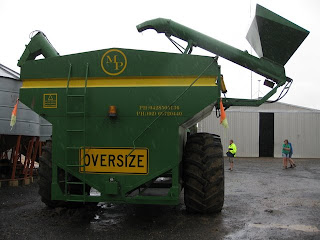We arrive home late Sunday evening after a 30 plus hour travel day. Everyone agreed that it was a great trip and we learned a lot, exactly what we were hoping to do. The group is pictured below. They were a great bunch to travel with. We will be working on a trip report for our partners and will likely provide access to it via the CTF Alberta web site www.controlledtrafficfarming.org
Eleven Albertans went on the trip:
The farmers included:
Craig Shaw, Lacombe – CTFA and Alberta Crop Industry Development Fund board (ACIDF)
Tom Machacek, Bow Island - ACIDF
James Jackson, Dapp - CTFA and Alberta Pulse Growers
Jamie Christie, Trochu - CTFA and Alberta Barley Commission
Jack Swainson, Red Deer - CTFA and Alberta Winter Wheat Producers Commission
Kevin Bender, Bentley - Alberta Canola Producers Commission
Mel Stickland, Red Deer - Western Grains Research Foundation
Steve Larocque, Three Hills - CTFA and Beyond Agronomy
Industry
Jay Bruggencate, Lacombe - Farmers Edge
Other
Alan Hall, Lacombe – CTFA and ACIDF
Peter Gamache, Edmonton - CTFA
We sat down the last day to hear a very informative presentation by GRDC and talked about the highlights and learnings of the trip. Steve Larocque, Beyond Agronomy, has a great summary of what we learned
- CTF doesn't have to happen overnight. You can progress into CTF over time as you begin to match up equipment widths and axel widths. Nobody says you have to flip a switch and go all in year one.
- CTF equipment set ups don't have to be expensive and I can attest to this. Many of the farms invested less than $15,000 to get into CTF and some took a few years while cash flow allowed.
- You don't have to be anal about CTF. For example, if you have to jump off a tram line to unload at harvest because you can't make it to the end of the run, then jump off and unload. The extra wheel traffic created by jumping off the tram lines to unload amounts to a very small percentage across the farm.
- CTF opens up a world of precision application opportunities: inter-row seeding to inter-row spraying herbicides, on-row spraying of fungicides and insecticides, in-crop fertilizer banding, and strip till banding fertilizer in the fall.
- CTF creates spatial awareness. With the aid of application and yield mapping you can begin to eliminate the variables that reduce yield in your cropping system. Once you reduce the randomness of input applications, you can start to extract valuable yield data because the placement of inputs is so precise.
- CTF improves the timeliness of input applications. We all know how important timing is in farming. With CTF, growers can get on the field sooner after a rain than conventional farming systems. Improving the timeliness of seeding, spraying and harvest can generate big returns.
- CTF reduces fuel use by 30 to 50%, with big savings during harvest. For example, drive a loaded combine weighing in excess of 60,000 lbs across a soft field and then drive it across a pair of hard packed tram lines. Needless to say, the reduction in fuel use is significant.
- On farm research becomes easier and the data collected more valuable with CTF. The pass to pass accuracy in a CTF system allows you to apply treatments and collect yield data knowing exactly how many rows you treated and how many rows you harvested. It eliminates the randomness like input overlap and harvest under lap that skews yield data.
The Alberta Crop Industry Development Fund arranged our trip and provide considerable funding as did the groups the members represented. A special thanks to Alan Hall for all the work he and the ACIDF office did.
I would like to thank our friends in Australia. Tim Neale and Andrew Whitlock of Precision Agriculture were brilliant and Sue McPherson of Travelworld, Toowoomba, was superb. All the famers and machinery guys we met were very accommodating and willing to share what they have been learning.
Hope you enjoyed the blog. If you have any questions please email me. Peter Gamache



























